Choosing the Right Wattage for Bathroom Lighting

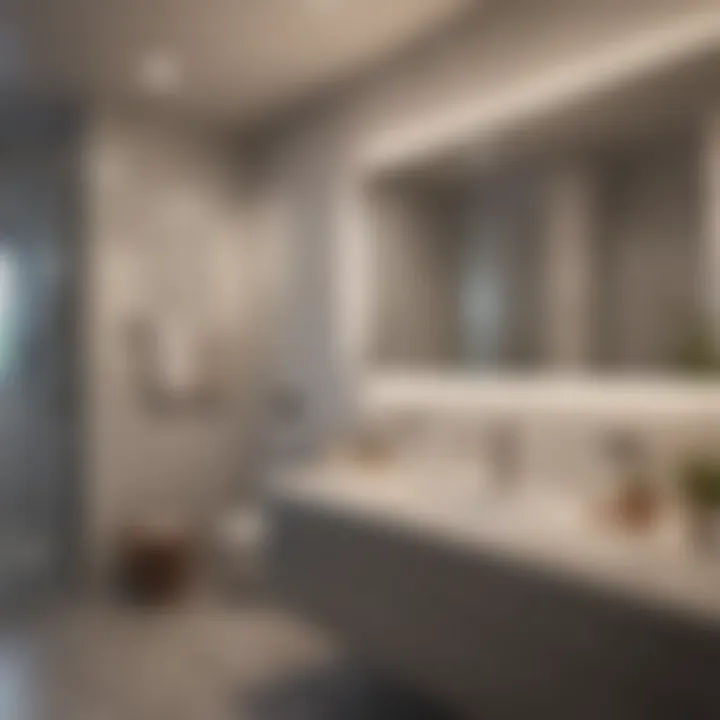
Intro
When it comes to bathroom lighting, nailing down the right wattage is crucial. After all, a bright and inviting space can set the mood for relaxation or energize you in the morning. Many homeowners often overlook this detail, thinking brightness is solely a matter of fixture choice. However, it’s not just about picking out a shiny new light; considering factors like room size, fixture styles, and the type of bulbs plays an integral part in achieving that perfect ambiance.
Whether you're planning a serene spa-like retreat or a vibrant space for day-to-day routines, understanding how to select the appropriate wattage can lead to a balanced and functional bathroom. Knowing the ins and outs of lighting can help curb common misconceptions too, such as equating high wattage with effective illumination—something that can sometimes lead to more glare than glow.
This guide will demystify the intricacies of wattage in bathroom lighting, of guiding you through critical aspects you should keep in mind, alongside practical recommendations tailored for your unique space.
Design Inspiration
Lighting not only influences visibility but shapes the entire atmosphere of a room. When determining the optimal wattage for bathroom lighting, it's worth considering current trends in interior design, as well as your own personal aesthetics.
Current Trends in Interior Design
Contemporary trends lean towards soft, diffused lighting that adds warmth to bathroom spaces. Think of designs incorporating LED recessed lighting paired with decorative fixtures. This combination provides a layered look, which can accentuate architectural features while avoiding harsh shadows. Using dimmers can allow flexibility in brightness, ensuring you can create the right mood at any given time.
Additionally, integrating smart lighting solutions is gaining traction, enabling homeowners to adjust brightness levels or color temperatures directly from smartphones. This not only enhances convenience but also fosters more control over the ambiance.
Color Schemes and Palette Ideas
Color schemes play a significant role in how light is perceived in a bathroom. Lighter colors tend to reflect light, making spaces feel larger and more open. If you're working with a smaller bathroom, consider a soft white or pastel palette; this will amplify the light from your fixtures. If you wish to inject a bit of character into your space, deeper shades can be paired with strategic lighting choices. For example, a navy blue wall could be beautifully complemented with warm yellow lighting.
One effective method to enhance your room is to use a three-tone palette that harmonizes with your lighting. For instance, mixing a warm beige, crisp white, and rich wood tones can create a soothing oasis, where light feels inviting rather than overwhelming.
While exploring these design inspirations, remember to continually relate your color selections and light fixtures back to the wattage you choose. Over-lighting can detract from an otherwise well-conceived design.
Ending
Ultimately, the journey to determining optimal wattage for your bathroom lighting hinges on your personal style and practical needs. Adopting these insights not only boosts the functionality of your space but also allows you to embrace your design aspirations fully. Let's continue exploring the nuances that can make your bathroom radiate comfort and efficiency.
Understanding Bathroom Lighting
Proper lighting in a bathroom isn't just about flicking a switch and having a lightbulb glow. It's a multifaceted subject that significantly affects both the functionality and aesthetic of the space. Many homeowners overlook this crucial aspect, often settling for inadequate illumination or over-the-top brightness, which can lead to a less-than-pleasing experience. Understanding the nuances of bathroom lighting can transform a mundane washroom into a tailored sanctuary, meeting both practical and stylistic needs.
When you walk into a well-lit bathroom, the ambiance is immediately felt. The right lighting can create a refreshing start to your day or serve as a soothing haven at the end of a long one. However, mismatched or poor lighting can hinder activities like shaving or applying makeup, making it hard to see what you’re doing. Hence, the quest for optimal wattage becomes vital in shaping your bathroom experience.
The Importance of Proper Lighting
Proper lighting can elevate a bathroom in several ways:
- Visibility: Clear visibility is paramount in a private space where tasks require precision. Think of applying skincare or styling your hair – it’s impossible without the right light.
- Safety: Bathrooms can be slippery, and dim lighting can lead to accidents. Adequate brightness enhances safety, providing peace of mind.
- Mood Enhancement: Whether through warm or cool lights, the atmosphere can change dramatically. A warm glow can evoke coziness, while cooler lights can invigorate you.
"Light is to the eyes what water is to the soul."
Thus, understanding the role of appropriate wattage in conjunction with various types of bulbs helps satisfy both practical needs and aesthetic aspirations.
Functionality vs Aesthetics
Finding a balance between functionality and aesthetics in bathroom lighting is akin to riding a bicycle – too much weight on one side, and you're bound to tip over. It’s easy to get lost in decorative pieces that look stunning but function poorly. While aesthetics and style play a substantial role, it’s essential that bathroom lighting serves its primary purpose first: functionality.
- Task Lighting: This refers to lighting designed for specific activities. Bright, direct light is necessary above mirrors or vanities to ensure that you can see everything without shadows. Here, a fixture with suitable wattage, installed correctly, becomes crucial.
- Ambient Lighting: The general illumination of the room should not be neglected. It's the stage setter for all activities. Ambient lights must create a warm and welcoming space without being overwhelming.
- Design Elements: Incorporating design-friendly fixtures and lamps can enhance the look of the bathroom. Ultimately, your choices should echo personal style while still allowing for practicability.
Though aesthetics can usher in a certain charm, the primary aim should always be effectiveness in lighting. Melding both aspects requires careful planning and consideration.
Wattage Fundamentals
Understanding wattage is like having the keys to a well-lit bathroom. This section lays the groundwork for one of the most essential aspects of bathroom lighting. Proper wattage not only dictates how bright a bathroom can get but also influences energy consumption and longevity of bulbs. Knowing how to navigate through wattage choices is critical for achieving both functionality and charm in this personal space.
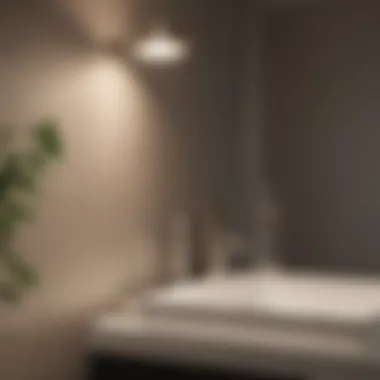
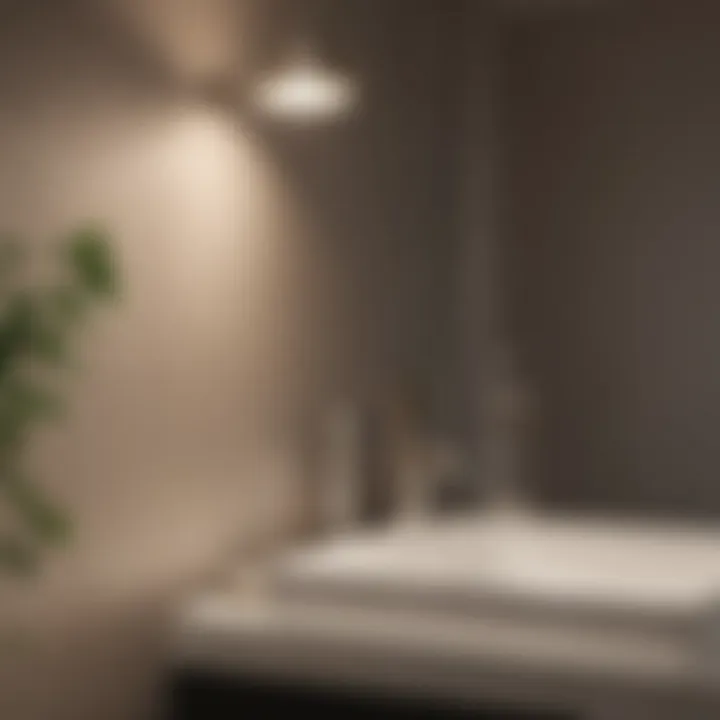
What is Wattage?
Wattage is a measure of electrical power. It's a number that often gets tossed around but rarely explained fully. In simple terms, wattage indicates how much energy a light bulb consumes. A higher wattage means more energy use but also typically suggests a brighter light output.
For instance, if you have a bulb rated at 60 watts, it’s using that energy to produce light. The catch? It's not always the best indicator of how much light you're going to get. Wattage alone doesn’t tell you everything; that's where lumens come into play. So it's wise to get familiar not only with wattage but also with how it ties in with other measures like lumens.
Lumens vs Wattage
Distinguishing between lumens and wattage is a big deal in the world of lighting. To put it frankly, lumens measure the amount of light emitted, while wattage measures how much energy is used. Think of it like comparing apples to oranges.
- Lumens tell you how bright a bulb is and are crucial for determining if a light can properly illuminate your bathroom.
- Wattage tells you how much power the light uses.
In modern lighting terms, LED bulbs throw a wrench in the old-school thinking that more watts equal more light. For example, a 10-watt LED bulb can produce the same brightness as a 60-watt incandescent bulb. Hence, it’s essential to look at both lumens and wattage when making decisions about your bathroom lighting.
Determining Brightness Requirements
Finding the right brightness for your bathroom is not one-size-fits-all. It depends on several factors, including the size of the room, the tasks performed there, and even personal preference. To tackle this, you can follow a general guideline measured in lumens. Here’s a quick rundown:
- For a small bathroom (about 50 square feet), aim for around 3,000 to 4,000 lumens.
- A medium-sized bathroom (around 100 square feet) usually needs about 4,500 to 6,000 lumens.
- Large bathrooms can require over 6,000 lumens to keep things bright.
"Lighting should adapt to our lifestyles; it should never feel like we are dimming our own potential."
Additionally, consider where you’re placing the lights. Using task lighting for specific activities, like grooming, alongside softer ambient lighting can hit that sweet spot for comfort. Always keep in mind that it's not just about how bright it is; achieving the right ambiance can make your bathroom feel like a luxurious retreat.
Bronze those wattage skills, and you'll find it simpler to have lighting that's not just functional but also sets the right mood for your bathroom.
Choosing the Right Wattage
When it comes to bathroom lighting, choosing the right wattage is akin to finding the perfect recipe to create the best meal. You wouldn't just toss ingredients together without a plan, right? The wattage of your light fixtures plays a crucial role in determining not only visibility within the space but also the ambiance and overall mood. Outfitting a bathroom with optimal wattage leads to a well-balanced mix of practical functionality and aesthetic appeal.
One of the main benefits of selecting the right wattage is that it reduces the risk of eyestrain from overly bright lights or dim corners that make daily routines challenging. Additionally, using appropriate wattage contributes significantly to energy conservation, which aligns with the increasing need for sustainable living. By addressing wattage head-on, you're not just thinking about illumination but also how that impacts your home life and energy bills.
Standard Recommendations
For bathroom lighting, a good starting point suggests around 80 to 100 lumens per square foot. This recommendation strikes a balance between providing the necessary brightness for grooming and maintaining an inviting atmosphere. Here's a quick breakdown:
- For a small bathroom (up to 50 square feet): 400-500 lumens.
- For a medium bathroom (50-100 square feet): 800-1000 lumens.
- For large bathrooms (over 100 square feet): around 1200 lumens or more.
When you want to create a layered lighting effect, you may consider different wattages for various light sources. While the general figures above provide a framework, it's wise to adjust based on personal preferences and specific uses of the space.
Factors Influencing Wattage Decisions
Understanding the factors that influence wattage decisions is key to lightening your load:
Room Size
Room size is perhaps the most straightforward variable that affects wattage. A larger room inherently demands more wattage, as fewer light sources will leave shadows lurking in corners. The key characteristic of room size is its direct relation to the amount of light needed. For instance, a small bathroom packed into a cozy corner of a home will require less wattage compared to grander spaces.
Unique about room size is its flexibility. It's relatively easy to adapt wattage needs based on the space. Larger rooms, however, come with their own challenges, often necessitating multiple light sources. This is useful for creating a more even dispersion of light, helping to eliminate those dark spots.
Ceiling Height
Ceiling height might seem like a subtle factor, but it carries weight in discussions about wattage. High ceilings can make a room feel airy, but they also require more wattage to ensure the light reaches all corners effectively. The principle here is simple: higher ceilings demand higher wattage to achieve the same illumination level as standard-height ceilings.
An advantage of high ceilings is the opportunity for overhead lighting features that add drama, such as chandeliers. However, maintaining the right light levels can turn tricky and calls for careful wattage considerations.
Color Scheme
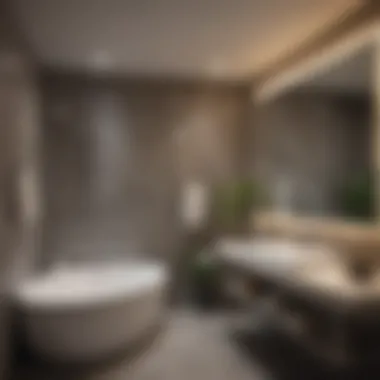
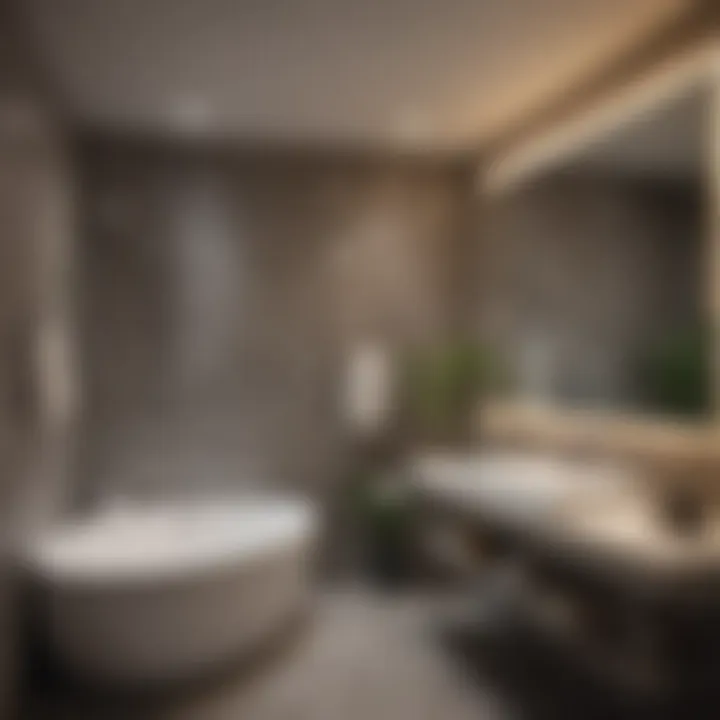
The color scheme of your bathroom might be the least obvious but is definitely an influential aspect in determining wattage. Light, neutral colors can reflect more light, causing a perception of brightness even with lower wattage. Conversely, darker paint shades may absorb light, thus requiring more wattage for adequate illumination.
The key feature of color schemes is how they interact with natural light. For example, a bathroom with large windows will need less wattage than a dark-painted space that lacks sunlight. It's essential to make a calculated decision based on the interplay of colors and the desired mood to avoid overdoing it or underwhelming with brightness.
Types of Light Bulbs
Choosing the right type of light bulb is crucial in determining the optimal wattage for bathroom lighting. Different types of bulbs offer varying advantages and performance characteristics that can affect both brightness and energy consumption. Not only does the choice of bulb impact how well a bathroom is illuminated, but it can also influence the overall aesthetic of the space. Understanding the distinctions between incandescent bulbs, compact fluorescent lamps (CFLs), and light-emitting diodes (LEDs) can lead to more informed decisions for your lighting needs.
Incandescent Bulbs
Wattage Ratings
Incandescent bulbs are famed for their warm glow and simplicity, often preferred by many homeowners seeking that classic look. The wattage ratings of these bulbs range from about 40 to 100 watts, typically correlating with the quantity of light they produce. Each watt offers a specific lumen output, so a 60-watt bulb emits around 800 lumens. What makes wattage ratings so well known is their straightforwardness:
- Understanding: These ratings help individuals select bulbs based on their brightness requirements.
- Familiarity: People are used to these wattage ratings, making shopping a simpler task.
Despite their popularity, people should consider that higher wattage means higher energy costs. Additionally, incandescent bulbs have a shorter lifespan compared to modern alternatives.
Advantages and Disadvantages
The primary advantage of incandescent bulbs lies in their ability to produce a warm light while being relatively inexpensive to purchase. They are also easy to dim, allowing for versatile lighting scenarios. However, disadvantages do exist. They consume more energy than other types of bulbs, leading to increased electricity costs over time. Plus, when they burn out, it's usually with minimal warning, which can leave a bathroom in the dark at an inconvenient time.
Compact Fluorescent Lamps (CFLs)
Energy Efficiency
Energy efficiency is at the heart of what makes CFLs an appealing option for many bathroom settings. With their ability to produce the same amount of light as incandescent bulbs using only about 13 to 15 watts, they stand out as a more eco-friendly choice. This efficiency can translate to lower energy bills and a smaller carbon footprint:
- Low Consumption: A 15-watt CFL can produce roughly the same brightness as a 60-watt incandescent.
- Longevity: They tend to last longer, reducing the frequency of replacements.
However, it's important to note that the initial costs of CFLs can be higher than incandescent bulbs, which might deter some buyers.
Wattage Comparisons
When looking at wattage comparisons among various bulb types, CFLs present an impressive advantage. While traditional incandescent bulbs require more wattage to achieve similar lumens, CFLs allow for significant energy savings without sacrificing brightness. This makes them a particularly valuable choice in the bathroom, where bright lighting is essential:
- Cost-Effective: Over time, the savings in energy bills can outweigh the initial purchase price.
- Brighten Up: They provide ample illumination while being less taxing on electricity usage.
Light Emitting Diodes (LEDs)
Longevity
Longevity truly sets LEDs apart from their incandescent and CFL counterparts. An LED bulb can last anywhere from 15,000 to 50,000 hours, meaning they won't need frequent replacements:
- Sustainability: Their long lifespan contributes to lower waste and fewer bulbs in landfills.
- Efficient Use: This trait makes them particularly advantageous in spaces like bathrooms, where light might be used regularly but also need to be reliable over time.
The trade-off, again, is the initial cost. While initially pricier, their longevity often leads to more savings in the long run.
Brightness Settings
Finally, brightness settings have become a notable feature of modern LED technology. Many LEDs come equipped with adjustable brightness levels, giving users control to set the ambiance of the bathroom according to the time of day or activity:
- Customization: This flexibility is a welcome factor for moods ranging from morning wake-ups to nighttime relaxation.
- Energy Savings: By adjusting the brightness, users can lower energy consumption, making LEDs not only user-friendly but also economical.
Placement and Design Considerations
When choosing the right wattage for bathroom lighting, placement and design considerations play a pivotal role. It's not just about how bright a bulb can shine; it’s about where that light is positioned and how it interacts with the space. Proper placement can enhance the functionality of the bathroom, making everyday routines smoother, while thoughtful design can elevate the atmosphere, providing a pleasant backdrop for both work and relaxation.
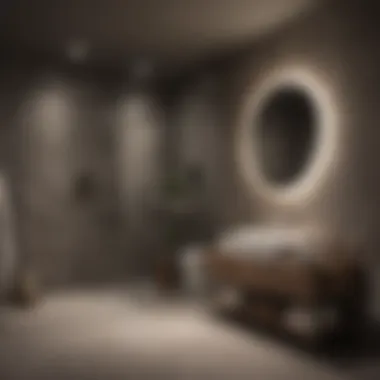

Layering Light Sources
Layering light sources involves incorporating different types of lighting to create a balanced and inviting atmosphere. This approach typically combines ambient lighting, task lighting, and accent lighting. Here’s how layering can work in the bathroom:
- Ambient Lighting: This is your base layer of light, often coming from ceiling fixtures or general-purpose bulbs. It provides overall illumination and fills in dark spots.
- Task Lighting: Necessary for practical purposes, task lights are focused and help with activities such as shaving or applying makeup. Sconce lights or vanity fixtures are often placed adjacent to mirrors to reduce shadows on the face.
- Accent Lighting: While not essential, this layer adds character. It can highlight architectural features or artwork. A spotlight on a decorative shelf or backlit mirrors can elevate the aesthetic appeal.
Utilizing multiple sources like this not only offers flexibility in brightness but also creates visual interest, making your bathroom a more dynamic space. Remember to consider wattage across these layers to ensure that no single area is overexposed or dimmed.
Task Lighting vs Ambient Lighting
Understanding the distinction between task lighting and ambient lighting underpins the art of bathroom illumination. Task lighting is all about serving a specific function, while ambient lighting sets the overall mood.
- Task Lighting: This specific lighting needs to be bright enough for functional tasks. For instance, a 100-watt equivalent LED bulb can be ideal for a bathroom with a double sink where two people may need to use the space simultaneously. Also, using dimmable options can be beneficial as they allow adjustment based on the time of day or specific needs.
- Ambient Lighting: This is the general light that fills the room. While it should be sufficient to light the entire space, it doesn’t need to be as focused. Think of choosing a soft 60-watt equivalent LED for a tranquil overall glow that complements your spa-like environment.
In practice, it's best to blend both types of lighting. Create a harmonious environment where task lighting enhances functionality without overpowering the softer glow of ambient lighting.
Remember: The goal is to achieve a balance where light serves both your practical needs and aesthetic desires, which in turn can transform even a small bathroom into a serene retreat.
Common Misconceptions about Bathroom Lighting
Bathroom lighting is often dismissed as a trivial aspect of home design. However, the reality is that many misconceptions circulate regarding how to best illuminate this important space. Understanding these myths is key for homeowners and design enthusiasts looking to strike a balance between functionality and aesthetics. By addressing these misconceptions, we can pave the way to enhanced bathroom experiences.
Myths Surrounding Brightness
One prevalent myth is that brighter light always means better light. This belief can lead homeowners to choose overly bright fixtures, creating an uninviting atmosphere. Over-illuminating a bathroom may wash out colors and create harsh shadows, making it more difficult to engage in tasks like shaving or applying makeup. It's essential to consider how the light interacts with color schemes and textures in the room.
Instead of simply increasing brightness, focus on achieving the right brightness levels through a balanced lighting scheme. Using a combination of ambient, task, and accent lighting can create a welcoming and functional environment. Ambient lighting provides general illumination, while task lights directed over mirrors help with specific activities such as grooming.
Another mistake is assuming that the same wattage works for all bathrooms. The actual wattage needed depends on room size, fixture type, and personal preference. Small bathrooms may only require lower wattage fixtures, while larger ones might benefit from extra brightness. A simple guideline is that a bathroom area of about 100 square feet often needs between 80 to 100 lumens for ambient lighting.
Energy Consumption Misunderstandings
A significant misconception revolves around the notion that higher wattage necessarily means higher energy bills. Many homeowners panic at the thought of incandescent bulbs running up their energy costs. However, it’s important to recognize advancements in bulb technologies. For example, switching to LEDs can drastically reduce energy consumption while providing equivalent brightness to higher-wattage incandescent bulbs.
Here are a few points to clear the confusion:
- LEDs vs Incandescents: LED bulbs may initially cost more, but their longevity and energy efficiency make them a wise investment. They consume 80% less energy than incandescent bulbs and can last up to 25 times longer.
- CFLs Availability: Compact Fluorescent Lamps, or CFLs, offer another energy-efficient alternative. These, too, use less wattage compared to traditional bulbs, which translates to lower monthly utility bills.
In sum, it’s beneficial to contemplate the bigger picture, looking beyond mere wattage to overall energy use. The technology behind light bulbs has evolved significantly, allowing for greater efficiency without sacrificing light quality. Choosing the right bulbs can lead to a well-lit and welcoming bathroom without breaking the bank.
By shedding light on these common misconceptions about bathroom lighting, we can empower homeowners to make informed choices. The goal is not merely to flick the switch, but to create a personal oasis — one that harmonizes practicality and elegance.
Epilogue and Recommendations
In the realm of bathroom lighting, understanding the optimal wattage is not merely a technical detail; it is a crucial component that ties together functionality and aesthetic appeal. The significance of this aspect cannot be overstated, as it impacts how users interact with their space on a daily basis. Properly selected wattage illuminates essential areas, reduces harsh shadows, and contributes to an overall atmosphere that is both inviting and practical. It’s a delicate balancing act of ensuring every corner of your bathroom is well-lit while avoiding an overwhelming brightness that can make the space feel sterile and unwelcoming.
The benefits of thoughtfully chosen wattage go beyond mere illumination. A well-lit bathroom enhances safety, aiding visibility for tasks like shaving or applying makeup, and it can also serve to highlight unique design elements of the room, such as decorative tiles or fixtures. Moreover, striking the right balance in brightness can facilitate energy efficiency, which is an increasingly essential consideration in today’s environmentally conscious society. This article has explored various elements that influence wattage decisions including room dimensions, ceiling heights, and personal taste in aesthetics.
Ultimately, when approaching wattage determination in bathroom lighting, consider your unique situation holistically to achieve the best result for your needs.
Summary of Key Points
- Wattage directly affects brightness and usability of the bathroom.
- Choosing the right wattage involves considering room size, fixture types, and ambient lighting needs.
- Different light bulbs offer varying efficiency levels in terms of energy consumption.
- A balanced approach to wattage aids in creating a welcoming and functional atmosphere.
- Illuminating key areas prevents safety hazards such as slips or accidents.
Final Thoughts on Wattage Selection
Selecting the right wattage for bathroom lighting is akin to crafting a symphony; every decision you make influences the overall harmony of the space. As we’ve unpacked throughout this article, it’s not just about number of bulbs or wattage ratings—it's about how these choices work together to create a holistic experience. Think about what activities take place in your bathroom: do you primarily use it for quick routines or longer leisure moments? This can guide your decisions significantly.
Furthermore, always experiment a bit. Sometimes what works on paper won’t translate perfectly into your space, so trust your instincts and adjust accordingly. Perhaps start with a versatile variable wattage fixture that allows you to test different settings.
"In lighting, there are no hard and fast rules; it’s all about finding what feels right for you."
By taking into account the insights shared here, you’re more equipped to tailor your bathroom lighting for both beauty and practicality. In the end, empowering your environment through lighting is a small but mighty detail that can lead to greater satisfaction with your home.
For further reading on lighting techniques, explore resources like Wikipedia or Britannica.



